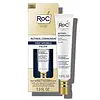What's inside
What's inside
 Key Ingredients
Key Ingredients

 Benefits
Benefits

 Concerns
Concerns

 Ingredients Side-by-side
Ingredients Side-by-side

Water
Skin ConditioningGlycerin
HumectantButylene Glycol
HumectantAluminum Starch Octenylsuccinate
AbsorbentPolyacrylate Crosspolymer-6
Emulsion StabilisingSorbitan Laurate
EmulsifyingPhenoxyethanol
PreservativeSodium Lactate
BufferingHydroxyethylcellulose
Emulsion StabilisingCarbomer
Emulsion StabilisingCaprylyl Glycol
EmollientAcetyl Dipeptide-1 Cetyl Ester
Skin ConditioningPolysorbate 20
EmulsifyingEthylhexylglycerin
Skin ConditioningTetrasodium EDTA
Potassium Hydroxide
BufferingT-Butyl Alcohol
PerfumingPalmitoyl Tripeptide-1
Skin ConditioningPalmitoyl Tetrapeptide-7
Skin ConditioningWater, Glycerin, Butylene Glycol, Aluminum Starch Octenylsuccinate, Polyacrylate Crosspolymer-6, Sorbitan Laurate, Phenoxyethanol, Sodium Lactate, Hydroxyethylcellulose, Carbomer, Caprylyl Glycol, Acetyl Dipeptide-1 Cetyl Ester, Polysorbate 20, Ethylhexylglycerin, Tetrasodium EDTA, Potassium Hydroxide, T-Butyl Alcohol, Palmitoyl Tripeptide-1, Palmitoyl Tetrapeptide-7
Water
Skin ConditioningPentaerythrityl Tetraethylhexanoate
EmollientGlycerin
HumectantPEG-8
HumectantPPG-15 Stearyl Ether
EmollientNylon-12
Butylene Glycol
HumectantStearyl Alcohol
EmollientCetearyl Alcohol
EmollientEthylhexyl Methoxycinnamate
UV AbsorberDimethicone
EmollientCyclohexasiloxane
EmollientCeteareth-20
CleansingIsohexadecane
EmollientButyrospermum Parkii Butter
Skin ConditioningRetinol
Skin ConditioningHydrolyzed Hyaluronic Acid
HumectantPolyacrylamide
Phenoxyethanol
PreservativeAmmonium Acryloyldimethyltaurate/Vp Copolymer
Caprylyl Glycol
EmollientPentylene Glycol
Skin ConditioningC13-14 Isoparaffin
EmollientTocopheryl Acetate
AntioxidantLaureth-7
EmulsifyingDisodium EDTA
Allantoin
Skin ConditioningDihydroxy Methylchromone
AntioxidantBHT
AntioxidantCyclopentasiloxane
EmollientHydroxyphenyl Propamidobenzoic Acid
Skin ConditioningAscorbic Acid
AntioxidantPolysorbate 20
EmulsifyingMethylparaben
PreservativeEthylparaben
PreservativePropylparaben
PreservativeParfum
MaskingWater, Pentaerythrityl Tetraethylhexanoate, Glycerin, PEG-8, PPG-15 Stearyl Ether, Nylon-12, Butylene Glycol, Stearyl Alcohol, Cetearyl Alcohol, Ethylhexyl Methoxycinnamate, Dimethicone, Cyclohexasiloxane, Ceteareth-20, Isohexadecane, Butyrospermum Parkii Butter, Retinol, Hydrolyzed Hyaluronic Acid, Polyacrylamide, Phenoxyethanol, Ammonium Acryloyldimethyltaurate/Vp Copolymer, Caprylyl Glycol, Pentylene Glycol, C13-14 Isoparaffin, Tocopheryl Acetate, Laureth-7, Disodium EDTA, Allantoin, Dihydroxy Methylchromone, BHT, Cyclopentasiloxane, Hydroxyphenyl Propamidobenzoic Acid, Ascorbic Acid, Polysorbate 20, Methylparaben, Ethylparaben, Propylparaben, Parfum
Ingredients Explained
These ingredients are found in both products.
Ingredients higher up in an ingredient list are typically present in a larger amount.
Butylene Glycol (or BG) is used within cosmetic products for a few different reasons:
Overall, Butylene Glycol is a safe and well-rounded ingredient that works well with other ingredients.
Though this ingredient works well with most skin types, some people with sensitive skin may experience a reaction such as allergic rashes, closed comedones, or itchiness.
Learn more about Butylene GlycolCaprylyl Glycol is a humectant and emollient, meaning it attracts and preserves moisture.
It is a common ingredient in many products, especially those designed to hydrate skin. The primary benefits are retaining moisture, skin softening, and promoting a healthy skin barrier.
Though Caprylyl Glycol is an alcohol derived from fatty acids, it is not the kind that can dry out skin.
This ingredient is also used as a preservative to extend the life of products. It has slight antimicrobial properties.
Learn more about Caprylyl GlycolGlycerin is already naturally found in your skin. It helps moisturize and protect your skin.
A study from 2016 found glycerin to be more effective as a humectant than AHAs and hyaluronic acid.
As a humectant, it helps the skin stay hydrated by pulling moisture to your skin. The low molecular weight of glycerin allows it to pull moisture into the deeper layers of your skin.
Hydrated skin improves your skin barrier; Your skin barrier helps protect against irritants and bacteria.
Glycerin has also been found to have antimicrobial and antiviral properties. Due to these properties, glycerin is often used in wound and burn treatments.
In cosmetics, glycerin is usually derived from plants such as soybean or palm. However, it can also be sourced from animals, such as tallow or animal fat.
This ingredient is organic, colorless, odorless, and non-toxic.
Glycerin is the name for this ingredient in American English. British English uses Glycerol/Glycerine.
Learn more about GlycerinPhenoxyethanol is a preservative that has germicide, antimicrobial, and aromatic properties. Studies show that phenoxyethanol can prevent microbial growth. By itself, it has a scent that is similar to that of a rose.
It's often used in formulations along with Caprylyl Glycol to preserve the shelf life of products.
Polysorbate 20 is made by combining ethoxylation of sorbitan, ethylene oxide, and lauric acid. It is a mild cleansing agent, surfactant, and emulsifier.
As a surfactant, it helps collect dirt and oils for washing. Emulsifiers prevent oils and water from separating.
Polysorbate 20 also adds scent to a product. Since it is made using sorbitol, it has a sweet scent. Sorbitol can also be found in fruits such as apples and peaches.
The lauric acid used to create Polysorbate 20 is often derived from coconuts.
Polysorbate 20 may not be fungal acne safe.
Learn more about Polysorbate 20Water. It's the most common cosmetic ingredient of all. You'll usually see it at the top of ingredient lists, meaning that it makes up the largest part of the product.
So why is it so popular? Water most often acts as a solvent - this means that it helps dissolve other ingredients into the formulation.
You'll also recognize water as that liquid we all need to stay alive. If you see this, drink a glass of water. Stay hydrated!
Learn more about Water